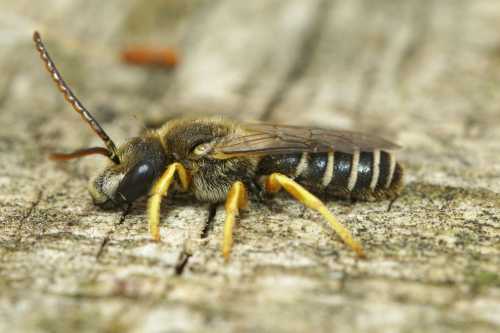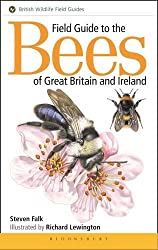Great banded furrow bee - Halictus scabiosae
The great banded furrow bee, Halictus scabiosae, is a fairly large species within the Halictus genera of bees of the bee family Halictidae. Females can measure just over 1 cm in length, males are a similar size.
This beautiful bee has distinctive abdominal bands. The antennae of males are quite long.
 Great banded furrow bee - Halictus scabiosae - male
Great banded furrow bee - Halictus scabiosae - male
All bees in the Halictus genera are categorized as short-tongued.
Where and when to see the great banded furrow bee, Halictus scabiosae
This species is found in Europe and in the Channel Islands (including Jersey, Guernsey, Sark and Herm) but not in Britain. It is especially visible between the months of July to September, although females may be seen as early as April.
It is widespread in a range of habitats, from gardens to flowery brownfield sites as well as coastal habitats depending on available floral resources.
Foraging habits
The name of this bee may give the impression that is has a narrow foraging range with a preference for scabiouses.
However, the species is polylectic (i.e. it will visit a wide range of unrelated plants).
Look out for bees foraging on knapweeds, Wild Carrot, Hogweed, scabiouses, bindweeds, Hemp-agrimony, Common Fleabane and various geraniums.
You may also catch sight of them on thistles, Bristly Oxtongue, Cat's Ear, Rock Rose and heathers.
An Italian study recorded visits to 27 flowering plants1 as follows:
Compositae:
Achillea millefolium, Buphthalmum salicifolium, Centaurea jacea, Centaurea nigrescens, Centaurea scabiosa, Cichorium intybus, Cirsium arvense, Cynara cardunculus, Crepis foetida, Crepis taraxicifolia, Erigeron annuus, Helianthus annuus, Helianthus tuberosus, Lapsana communis, Picris hieracioides, Senecio inaequidens, Taraxacum officinale, Tragopogon pratensis.
Convolvulaceae:
Calystegia sepium.
Dipsacaceae:
Knautia drimeia, Knautia illyrica, Scabiosa triandra.
Labiatae:
Hyssopus officinalis, Mentha longifolia.
Lythraceae:
Lythrum salicaria.
Plantaginaceae:
Plantago lanceolata.
Ranunculaceae:
Ranunculus acris.
Nesting habits of the great banded furrow bee
These bees nest in aggregations in south-facing, sloping sites such and also in sandy areas.
According to Falk in Field Guide to Bees Of Great Britain And Ireland, in some populations, an over-wintered female may act as queens with smaller non-productive daughters carrying out the duties of workers (foraging) whilst the egg-layer remain in the nest. However, this is not always the case. In other communal nests there may be more than one reproductive female.
Indeed one study by Ulrich et al2 confirmed that females have multiple reproductive strategies, resulting in a large diversity in the social structure of nests. The study combined field observations and genetic data.
Other key findings of the study were:
- Analysis of 60 nests revealed that 55% of the nests contained the offspring of a single female, whereas the rest had more complex social structures, with three clear cases of multiple females reproducing in the same nest and frequent occurrence of unrelated individuals.
- 31% of Halictus scabiosae nests were founded by more than one female.
- Drifting among nests was surprisingly common: 16% of the 122 nests in the overall sample and 44% of the nests with complex social structure contained females that had genotypes consistent with being full-sisters of females sampled in other nests of the population.
- Drifters originated from nests with an above-average productivity and were unrelated to their nestmates. The researchers suggest that drifting might be a strategy to avoid competition among related females.
References
1. Laura Fortunato, Pietro Zandigiacomo, Fenologia e preferenze florali di Halictus scabiosae (Rossi) in Friuli Venezia Giulia, Bollettino Soc. Naturalisti “Silvia Zenari”, Pordenone 36/2012 pp. 147-156 ISSN 1720-0245
2. Ulrich Y, Perrin N, Chapuisat M. Flexible social organization and high incidence of drifting in the sweat bee, Halictus scabiosae. Mol Ecol. 2009 Apr;18(8):1791-800. doi: 10.1111/j.1365-294X.2009.04154.x. Epub 2009 Mar 19. PMID: 19302463.
If you found this page helpful or interesting, I'd really be grateful if you would share it with others - if not this page, perhaps another, such as Gardening For Bees.
Thank you so much :) .
